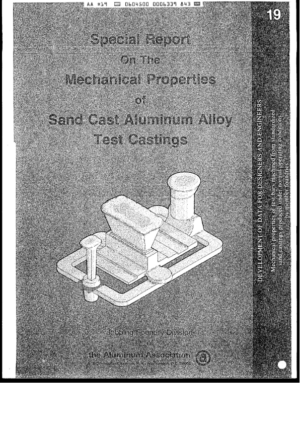AA 19:2000
$6.50
Special Report on the Mechanical Properties of Sand Cast Aluminum Alloy Test Castings
| Published By | Publication Date | Number of Pages |
| AA | 2000 | 6 |
Many variables affect the mechanical properties in aluminum alloy castings. The most important of these are:
1. Alloy and the variation of the chemical composition within the specified limits for that alloy.
2. Metal soundness. This can be affected by gas porosity, shrinkage porosity and non-metallic inclusions.
3. Metallurgical characteristics. Examples are macro grain size and constituent distribution.
4. Solidification rate. This will likely vary throughout the casting. It is affected by section thickness, location with respect to gates and risers, metal flow in the mold cavity, special chilling techniques. Solidification rates can be directly related to dendrite arm spacing with smaller cell sizes indicating more rapid cooling and higher mechanical properties.
5. Heat treatment – optimum time and solution heat treat temperature to ensure solution of the soluble constituents, proper quenching to retain those constituents in solution, and artificial aging to the desired temper.
Foundrymen can and do control alloy, chemistry and heat treatments rigidly. It is possible to control grain size and constituent distribution. Good melting and degassing practices will control oxide inclusions and hydrogen gas porosity. The major variations in mechanical properties then come from the ability to control shrinkage and the solidification rates attainable in a casting.
This report is an attempt to show the relationship of mechanical properties to some of the variations in solidification rate which might be expected in a casting. To do this, a test casting as shown in Figure 1 was designed by the Aluminum Association's Technical Committee on Castings. Patterns were made and distributed to at least six Jobbing Foundry Division member foundries. The foundries made test castings from several melts. The test castings from all foundries, along with separately cast test bars from each melt, were heat treated at one facility. Test bars (0.250" diameter with a 1" gauge length) were then machined from sections 1 through 6 in each test casting.
The test results for each alloy are presented in tabular form to show the relationship of properties to gating, section thickness, and chills; and also, to show in a graphical form the relationship of the properties to solidification rate as represented by dendrite arm spacing.
The test values shown relate only to the test casting. They represent good foundry practice and favorable casting design. The values are intended as a guideline for commercial design purposes, but they are neither the maximum nor the minimum properties obtainable. The ability to apply increased chill rates could improve the properties, while casting design limitations which restrict the foundry's ability to produce sound sections will reduce the properties. The design considerations and casting techniques for each particular casting will therefore affect the properties in that casting.






































